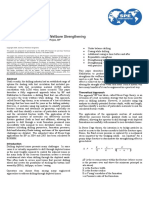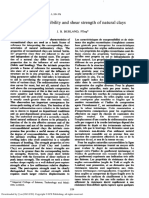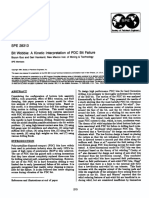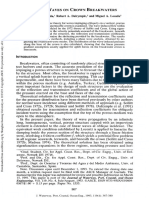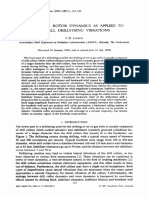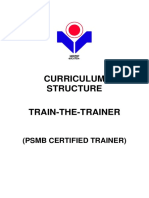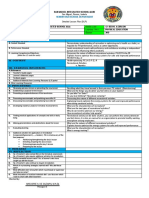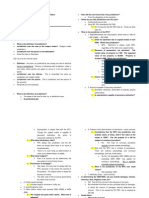Professional Documents
Culture Documents
Failure of Inclined Boreholes - Bradley
Uploaded by
John SeversonOriginal Title
Copyright
Available Formats
Share this document
Did you find this document useful?
Is this content inappropriate?
Report this DocumentCopyright:
Available Formats
Failure of Inclined Boreholes - Bradley
Uploaded by
John SeversonCopyright:
Available Formats
Failure of lnclined Boreholes
W. B. Bradley'
A th.eorerical
ntoder oJ'borehore fairure has been deueropecr which precricts
M anage r. c'onditions for pressure'incruced rosr circuration (riydiautic jio'r{rrirsl the
Technical Services,
borehole collupse. Tke mocrer can be used to cctrcurateinr antr
Reed Tool Company, riraiiii^ oj trorrnop
failure in uerrical ancl diret.tional wells under normal ancl recronic in_si/u stress
Houston. Tex
N4em ASI\4E condition"s' The resu/t's shrtw that det,iation and ho/e
direction- t:ct-n-signilicantly
influence both los/ t'irt:ulation and borehore coilapse.
rn, irpir ronrctl'ies witn an
illustration on how this theoreticar mocrer can be used r,
serect proper mucr weights
t o preuen I bo re ho le.l'a iIu re.
Introduction
Boreholc instability is a continuing problerl which resr-rlts in
substantial yearly expenditure by thc pctroleum industry. As a
rcsult, a major concern ol the drilling engincer is keeping rhe rEisrLr ( LOtt
F^TLURE crRcuLAlrot
borehole rvall lrom lalling in or brcaking down. Detailed at_ 1.
tention is paid to drilling fluid programs, casirrg programs,
and operating proccdures in clrilling a rvell ro minimizi these
costly'problcms.
l. adclition to the c.sts .ss.ciated rvith borehole stabilitv
r,''hile clrilling, borehole stabiliry has a subsrantial impact
on
prodr-rction problerns. For cramplc, the ability to clrill gage
ltolcs rrould havc 1rltn;11.lrrr irupa..t irr proclut:ing operatioirs
as follows:
1 improved cementing resulting in fewer squeezes and better
zonal isolation,
2 improved sand control performance as a result of im_ mrP R ESSrvE
proved cementing, FA I !URE
3. reduced perlorating problems due to thick cement sheaths, 2
thus higher producriviry,
4 improved log response and thus better evaluation,
Furt.hcr, the undcrlying theory used in borehole failure pro-
..
blerns in drilling is the sarne as rcqr,rired lor treating such pro_ )
duction problcnrs as open hole completions, sand control, and
s.t.imularion fracturing. The work cliscussecl in this papei Fig. 1 Types of borehole lailure
has
direct applicatiolt to these problen.rs.
u'eakened by interaction with the drilling mud to produce
)
Theoretical Development
boreholc lailure (lor exarnple, ,uater sensiti-ue shales).
Causes of Borehole f ailure. Formations at clepth exist To keep the rock lrom lailing, a number of things are done.
under a state of compressive in-situ stress. When a well is First, a rnud is selccted that minimizes the wcakening of the
drillcd, the rock surrounding tl-rc boreholc must support the rock, Second, the prcssure in the well bore is increised by
load that was previously taken by the removed roc*. As a weighring up the mud and adcling I'iltrate conrrol so thar
result, thc I'role produccs an increase in the stress around the the
well bore pressure carries some of the load imposed on the
hole (a stress concentratiolt). If'the rock is not strong enough, well bore'"vall by the in-sitrr srresses. By haringihe well bore
the boreholc u,ill fail. ln many cases, the rock is sufficientlv pressure carry some of the load, the stress on the
formation at
the borchole wall is reduced and compressive failure is
hn*'ork presented in this papcr u.as donc *.hilc rhe author rias on the
averted. However, increasing the mud *.ight too lar rnay
stalf result in the fornration splitting in a tensile fracture causing
ul \lr(ll De!clonurerrr ( r,. il Hourron. I, r.
lost circulation. Therefore, a balance is needed in the mud
Contributed by the petroleum Division ol THE AMERTCAN Socrrry or weight to prevent hole collapse without fracturing.
Mu:IT.1..nl ENGNEERS and presented ar thc Energy Technology Conference Stress-induced borehole failures can be grouped into the
and Exhibition, Houston, Texas, November S_S, f97g. Manuscript received
ASME Headquarters July 21, l91g: revised manuscript received August
at following three classes as is shown in Fig. l:
21,
1979. Paper No. 78,Per-44.
I Hole size reduction due to the plastic flow ol the rock in_
232 I Y ol. 101, December 1929
Transaclions of the ASME
to the.borehole (flowing shale and salt). Symptoms of this result of this change in in-situ stress, borehole stability pro-
condition are repeated requirements of reaming to bottom blems associated with drilling in tectonically active areas are
and, in extreme conditions, stuck pipe. significantly increased.
2 Hole enlargemenl due to rock failing in a brittle manner Besides the in-situ stresses discussed above, an additional
and falling into the borehole (sloughing shale). problems formation stress smust be consisered, namely, pore pressure.
resulting from hole enlargement inciude fill on trips, poor For normally pressured formations, the pore pressure gra-
dircttional conrrol, and poor cementing. dient is constant at approximately 0.46 psi,zfoot (10.4
3 Fracturing due to the tensile splitting of the rock from ex_ kPalm). In geopressured formations, pore pressure gradients
cessive well bore pressure. Severe loss ol'drilling fluid psi/ft (20"4kPa/m).
to the can exceed 0.9
formation from fracturing causes lost time u, *Jl u, increas_ Around the Borehole. with the introduction of the
Stresses
ed costs and often results in well control problems
experienced borehole, the in-situ stresses are significantly modified near
as a kick or an underground blowout.
the borehole wall. ln this paper, the formation around the
To understand borehole failure problems, the engineer borehole is modeled as a linear elastic solid in a condition of
needs to know: plane strain along the axis of the borehole. Flow of fluid into
(a) the stress in rhe formation before drilling the hole (in_situ or out of the formation is not considered. For this situation,
stress), the stresses around the borehole can be written using Kirsch,s
(D) the additional load on the rock resulting from solution togcther with a solution by Fairhurst [4]. While
the hole,
(c) how the load on the rock is alfected by mud pressure, strictly a linear theory, experience has shown that when com-
(d) the strength ol rhe rock, and bined with the failure criterion discussed in the next section,
(e) how the mud aflects the strength of the rock. reasonable predictions of failure are obtained for a wide range
of rock ductilities.
In-Situ Stress. Cenerally, f'ormations are classed in terms Considering compressive stresses as positive, fluid pressure
of in-situ stresses as either normally stressed or tectonically as positive, and using polar coordinates, the stresses at the
stressed. In a normalJy stressed region, the maximum in_sitr.r well bore wall can be written as follows: (equations for the
stress (or) is vertical and is equal to the overburden stress. In stresses as a function of radial distance away from the well
addition, the other two principal in-situ stresses (ot, o), bore are presented in the Appendix).
located in a horizontal plane, are equal or nearly equal. F'br
well compacted and cemented formations, the overburden o, : Pr",
stress varies linearly with depth, with a gradient approximate- oa : (6^ * o, -P,,) - 2(o,. - o,) cos2g
ly equal to I psi,zft (22.6 kpa/m).
,u * or,, ,!{iui]"'u '
o' -
In sedimentary basins that are slill unclergoing compaction, o: : o-- vl2(o, - o, ) cos
theoverburden gradient varies with depth. Fig. 2 (a), taken TrA : (r)
from reference Il], shows the variation in overburden gra- Tt): 2(.- r.r, sin d + zr,, cos 9),
dient with depth for the Gull Coast region. For Culf Coast 'ra 0
For the case of a vertical borehole in a normally stressed
sedirhents, the ratio o, ,/o1 [shown as (o1
- p,,) / (o1 - p,,)
where P,, is the pore pressure] also varies u,ith depth and this region (i.e., o, -- oz I o.,), equations (l) reduce to the more
isshown in Fig.2 (b). Fig. 2 (b) is taken from information lamiliar form
in reference [2] and shows the average trend with depth. For D
ot.
information on specific areas, the reacler is relerred to
references Il and 2].
o, 2o11 - P*,
o, or:
Tectonic stresses include all stress conditions which are not
considered normally stressed. Tectonically active regions are where
often associated with areas having active faults, sali clomes, O,, On: O- the normal stress components
or foothills. In tecronicaily active areas, the principal in_siru 774 T4r, Tr- the shear stresses
stresses are not necessarily oriented in the vertical and '
horizontal directions, but may be rotated rhrough significanr
oi, ov o-_ the normal in-situ stresses rotated to the
borehole coordinate frame
angles. ln addition, the magnitudes ol the three principal in-
situ stresses are usually different. For exampli, near salt
Trv, T"i, Tu, in-situ shdar stresses in the borehole coor-
dinate frame
domes evidence [3] indicates that the in-situ stresses are
horizontal in-situ stress in a normallv stressed
significantly altered from the normally stressed state. As a
region
Nomenclature
(S - P,,) : elfective average nor- frame
borehole radius mal stress /\r,/.\-rll- : in-situ shear stresses
average shear stress (o, - P,,) : effective principal rotated to the borehole
(square root of the se- stress coordinate reference
cond invariant of the r,0,2 : borehole cylindrical frame
stress deviator) coordinates 0, - radial normal borehole
J r.'"
",,
effective collapse stress z: poisson's ratio of the
stress
/z f! bor.hol" average shear stress at formation O0 : circumferential normal
the borehole wall 0,.0. : translormation angles borehole stress
Y1
rock lailure average rock shear o1,o1,o1 : principal in_situ o, axial normal borehole
strength at the average stresses stress
effectivce normal stress os : horizontal in_situ stress T
rq, T q, T,.. borehole shear stresses
(S - P,, ) for the point in a normally stressed oP largest tensile stress at
in consideration region the borehole wall
Po= pore pressure ox,o'oa: in-situ normal stresses OD effective fracturing
P,= well bore pressure rotated to the borehole stress, effective prin-
s= average normal stress coordinate reference cipal stress
Journal ol Energy Resources Technology December'1979, Vol. 101 1233
OVERBURDEN GRAOIENT
(KPr /M)
18 t9 20 l8 t9 20
--+--------1----- #
\
\
N. Ft( t3t ,AR
\ \ \
\
lr
-> l, +- ,\
: \L] ,rl
o c \3
ti;l-
lrr
6
z
,\\ l'-1-.
l-.
r.l_ 1
lt
H?+- \\p
-: tIl \a 2""o gl
-o N"+-
ll-"t Efl -l
r-
\.lrI O-
al i 'il
Fl lo
\\
ol {r
o rr i
cl rl \\i
5 tl: ;r r: \i-
roooo
o
I
o E[! -
_51 rla .".. ;l
l?T-P-
I rl
:r\
eooo
a
g I l?.1\-
_-l lql
1\
I
iE r\
rdl, rB
33EF r-
l
':lo
raooo
rt tarl
_ .. l__
i-
6t rl
r6000
r.o .8 .9 to 8 .9
OVERBUROEN PRESSURE GRAOIENT
PSI /FT
t.o
-4
LE GE ND .t
r. so. xaRsH tsL. 6
3. EUGENE ISL. I58 7il
4. EUGEr{E tSL. 128 ta
5. EUGENE ISL. I75
6. SHIP SHOAL 274
7. so.tARsH rsL.73
8. WEST CAf,EROn t9s .t
9. EUGE|{E tSL. 876
o. sHrP sHoAL e50 {ll .t
il. ra[{ PASS P90
iil .a
.l
[[rttalltat?tat,!o!t
DYitaittc ELAsTrc r{o0
aooo looo aooo 7000
AVERAGE DEPTH (FT)
rooo t000 tooo 8!oo
lyE!a9E__9E!I!__l!L
Fig.2 ln.silu stress behavior in the Gull Coast as a tunction of depth
234 l Y ol. 101, December 1979 Transactions of
I
i I
CURVE A
t 6.
t = o IO iTALLY
SliE3SEO CONOtTtOt3
ri-3lTU 3rRE33
q.o.e6 nt/FI to.c xet/tt
qI 6{ O.A5 Pst /rf tts.z tP^n I
FI cr. t.oo P3t/Fr 122.a x ?^,hl
t
1
oi
Eil
<il
*ll MINIMUM HORIZONTAL STRESS
I v..(v fril
I GRADIENT FOR CURVE A
tg. . o
ril
Eil
I CURVE 8
TECTOXTC
3TRE33 @iOrTtON!
il
t - srru stiE33
v' r' Ell
Mll{lMUl,
HORIZONTAL \
\
ot'o.ra at t /ar
q'o.q ?.t/n
ot''oo r'l n
ltl
t..t
/'' + .\
qil SS GRAOIENT
FOR CURVE 8
// ,',/ .',\\\\\
Jil
a t'll
, o f--is ,,'2)
PORE PREgSURE GRAOIET{T
a
I.i"IA
/..___Jv/ leEEnelEINGIE QEGREES
Fig.4 The ellect ol hole angle on tracture breakdown gradient
Fig. 3 Fraclure orientations
t (tensile), fracturing of the rock will occur
0= angular polar coordinate op - the least compressive stress at the well bore wall
I
P,, :well bore pressure Po : the pore pressure.
z: the Poisson's ratio of the formation. Equation (3) states that when the effective fracturing stress is
For a nonvertical hole or a hole that is not lined up with one lessthan or equal to zero (that is, tensile), tensile failure will
of the principal in-situ stresses, the in-situ stresses need to be occur. This tensile failure criterion is conservative and does
rotated into the coordinate frame of the borehole to get the in- not include the rock tensile strength, but models the case of
situ components needed for equation (l). weak rock or rock that contains uncemented fractures.
The orientation of the fracture with respect to the borehole
a Rock l'ailure. Boreholes fail either by exceeding the tensile depends upon the orientation of the least compressive stress.
i
strength ol the rock or by exceeding the compressive strength Fig. 3 shows the three types ol tensile failure which can occur.
of the rock. As the pressure in the well bore is increased, the
Referring to equation (l), for the condition that ru, : 0 and
I
stressesin the rocks become tensile, resulting in fracturing of ou I o--, a fracture parallel to the axis of the borehole, a
a the rock and lost circulation problems. With insufficient well "vertical" fracture will be formed. For the condition rr, : 0,
bore pressure, the compressive strength of the rock is exceed- o-- 1 o11, a fracture will form perpendicular to the borehole,
ed and the rock fails in compression. If the rock is in a brittle
a "horizontal" fracture. For conditions where 16, I 0, a frac-
state, compressive failure produces rubbling of the rock
I ture will be lormed that is inclined to the borehole axis. The
.|i (sloughing), resulting in hole enlargement. Rocks which
orientations of these fractures are the orientations at the well
behave plastically under compressive loading wiil flow
bore. As the fracture moves out away from the well bore and
plastically into the hole, resulring in a right hole.
the effect of the weil bore on the in-situ stress state
Rock behaves differently in tension than in compression
diminishes, the fracture will orient itself perpendicular to the
and as a result, a separate failure criterion is required to principal in-situ stress.
Ieast
describe each type of failure. Since the ntaximum stress state
For a vertical borehole in a normally stressed formation the
always occurs at the well bore wall, lailure will always be in-
state of stress is constant around the borehole as is shown by
itiated at the rvall. As a result, equations (l) can be used to
equation (2). By combining the tensile failure criterion, equa-
calculate the stress conditions for failure. tion (3), with the expression for the hoop stress, equation (2),
Tensile Failure. Rocks have generally weak tensile the well bore pressure necessary to cause fracturing and lost
stiengths, usually less than 1000 psi and seldom greater than circulation can be written as:
3000 psi. In addition, most rock masses contain joints, frac- Pu:2o11- Pr,, (4)
tures, or flaws which although closed may not be cemented
together or only weakly cemented together. As a result, the
Examination of equation (4), noting that the minimum in-situ
stress is always greater than or equal to the pore pressure,
tensile strength across these lractures is usually much lower
than the tensile strength ol the rock itsell. Therefore, we
shows that the well bore pressure required lor fracturing is
always larger than or equal to the minimum principal in-situ
t choose a tensile failure criterion which can be expressed as:
o1r"s1 :ot,-Pu'0 (3)
stress.
For nonvertical boreholes or vertical boreholes in tec-
where tonically active regions, the well bore pressure necessary to in-
itiate fracturing and lost circulation is reduced from the values
oo.,, : efiective principal stress or effective fracturing predicted by equation (a). Fig. 4 shows some typical results.
{ - when or",., ir less than or equal to zero
stress The results shown in Fig. 4 were calculated using the equation
Journal of Energy Resources Technology December 1979, Vol. 101 / 235
FAILURE
oll
uilt
lr,
tl ll
Fll
6ll
rll
<il
oll
6ll
ull ull
EI
-ll
oil Fll
6l
-ll
<il 5ll
ull ull
>il rll
all
*llJI =ll
<tl
Nll
STATE OF STREgS
ROUND EOREHOLE
-ll ELASTIC REGION -ll FOR: gr ' 30'
0x'45'
sll
4
(s-Po )
(s-% )
EFFECTIVE MEAN NOR
EFFECTIVE MEAN NORMAL STRESS
Fig.5 Extended Mises representation ol lailure
Fig. 6 Stress cloud
(l) along with the tensile failure criterion equarion (3). Under
the conditions shown in Fig. 4 well bore pressures significant-
ly below the vertical hole fracture gradient can produce frac-
turing and possible lost circulation. For extreme conditions,
well bore pressures below the minimum principal in-situ stress
can cause lost circulation. Under these extreme conditions, the
fracture cannot extend indefinitely into the formation, but D Fig.
will be restricted to a region in the immediate vicinity of the lun(
borehole. However, extensive fracturing of massive vertical E
wei!
ts
sections may produce sufficient lracture surface area to cause
e
significant lost circulation problems.
I
Compressive Failure. Compressive failure of rock has been
extensively studied, see for example reference [5]. Recent
results [6] have shown that the intermediate principal stress
€!l9tt0 REoroi
plays an important role in the lailure of rock. The effect of
the intermediate principal stress on the failure of rock can be
conveniently represented by the stress invariants -/2 n and (S
- Po) defined as: (s-Po)
r r, f I
12 _EIfEqlvE ME4!_I9E!4!_!MSS
-t? llo,-or)'*(o2-o)2 Fig.7 The J2% , 15 - Pol plane - elastic region and lailed region
* (o: - rrr'l] (5)
D
visualization aid is the "stress cloud." For a particular hole
angle, hole direction, and in-situ stress condition, the state of
,s.-P.:
Iq*i"t]-.. (6)
stress around the borehole can be represented by a closed
curve in the Jr"", (S - P,, ) plane (Fig. 6). Equation (l) shows
where this variation with the angular position (0) around the
borehole. Then, families of curves such as the one shown in
Jr'" : the root mean square shear stress (square root Fig. 6 could be plotted for a change in one of the parameters,
of the second invariant of the stress deviator) for example, borehole inclination, and the effect of this
S-Po : effective mean normal stress variable on the resulting lamily of curves observed. Unfor- Fir
o,1 ,03: the least, the intermediate, and the greatest
1o1 tdnately, the curves do not vary smoothly with a change in str
principal stress, respectively. variable and the resulting picture is difficult to use. However,
When the experimental lailure strengths ol rock at several dif- by using a computer to calculate and plot all the possible t\
ferent confining pressures are plotted in the ./, , , (S - p,, ) states of stress for all hole angles and hole directions, an area stl
plane, failure curves such as shown in Fig. 5 are obtained. in the -/r n, (S - P,, ) plane can be defined. This "stress cc
cloud, " then, represents the accumulation of all the curves lor OI
Borehole Failure all hole angles from 0 to 90 deg and for all hole directions hi
around the compass (actually, only hole directions from 0 to cl
Stress Cloud. Because of the large number of variables in- 90 deg need to be calculated because of symmetry). Now with St
volved (twelve), a major problem in working with the stability this stress cloud, a change in variable such as well bore Fi
of inclined boreholes is visualizing how each variable con- pressure or pore pressure can be seen as a change in shape of m
tributes to the stability or insrability of the borehole. A con- the stress cloud and a movement of the stress cloud in the St
cept that has been developed and found useful as a gross lrh,(S-P,)plane. al
236 / Vol. 101, December 1979 Transactions of the ASME
o.790 ( r7.9)
o.775 ( t7.5 )
o.727 |6.41 F ILURE
EI ETiVELOPE
0.675 ( 15.J)
:l
0.625 ( t4.r)
PSt/F1 IKP^/M) il
FRACTURIIG ANO
LOST CtRCULATtoN
1!
OCCURS H€RE
(s - Po)
EFFECTIVE IIEAN NORTAL STRESS
PORE PRESSURE
o.500 (il.3) Por> Po.) Po'
o.5r9 0t.7 )
o.572 (r2.9)
-0.6
o.625 ( r4. r) fl /,^,,u.,
ENVELoPE
il o.* I
-.-.._t
I
:l /a
il rO.O!
o152046607a90
BOREHOLE ANGLE. CEGREES
il
W/
Effective fracturing stress and elleclive collapse stress as a EFFEcrlvE MEAN xoR
olboreholeangleinanormallystressedlormationlorseveral Fig. 10 The effect of well bore pressure and pore pressure
ol mud loCation of lhe stress cloud
on
failure envelope and represents a stable borehole for all hole
angles and hole directions. Cloud B is intersected by the
failure envelope so that lor the conditions represented by
@
a FAILURE
cloud B, the borehole will be stable for some hole angles and
t! hole directions and unstable lor others.
t ENVELOPE
F
a Borehole Collapse. A measure of the borehole stability or
0a
instability can be made by defining an effective collapse stress
U
I
a
z Jz' :Jz rrocktaiturc /2 ib.rr.'h,.I. (7)
UJ
"rr
where
/:'ett : the elfective collapse stress
-\ /2 ' the average shear stress at the point on the
a bo, chole -
borehole wall under consideration
/2 i rn.l tailurc : the average rock shear strength - evaluated
at the same (S - P,,) value as exists at the
(s-Po) point ol consideration, see Fig. 7.
Then lrom Fig. 7 and equarion (7), a positive value of the ef-
EFFECTIVE MEAN NOR
fective collapse stress represents a stable condition at the point
The effecl ol in.situ stress on the shape and location ol the under consideration and a negative eflective collapse stress
represents an unstable or failed condition. Fig. 8 shows the
maximum effective collapse stress value around the borehole
te failure envelope divides the J, :, (S - p,, ) plane into wall plotted as a lunction of borehole angle for several dif-
Iegions, a failed region and an clastic region. Srates of ferent mud weights.
lying in the elastic region are stable and will not fail in
Points lying in the failed region represent states Borehole Fracturing. The stress cloud can also be used to
that exceed the compressive strength of the rock and indicate conditions of fracturing and lost circulation, by
failed. Then, by examining the location of the stress replacing the plotted dots with an x for each stress condition
to the failure envelope, the stability or in-
with respect where lracturing and lost circulation occurs, Fig. 7. Alternate-
yofthe borehole can readily be seen. For example, in ly a measure of the tendency lor fracturing and Iost circula-
, cloud A lies wholly above the failure envelope which tion can be defined using the eflective fracturing stress equa-
that for the particular conditions represented by this tion (3). Plotting the effective fracturing stress as a function
cloud the borehole will be unstable for all hole ansles of borehole angle, Fig. 8, provides a representation ol how
directions. Cloud C of Fig. 7 lies entirely beneath the close the well bore is to fracturing and losing circulation. As
ol Energy Resources Technology December .l979, Vol. 101 l23l
to
a
-4, \"a.
\%
cY"a7
to
STAELE EOREHOLE
MUD wEtGxr - psllFT
lt^tlt tot!xol:
o. oti:cttor
luo welext _ Les,/cnL
tl to
tuo wetcxr- xo,,/t{!
Fig. t1 Hote anqte r",,rr:.1:llr"cturing and coilapse
",
ol mud weight for a normally as a tunction xuo wgtoxr - les.,/eal.
slressed ,ormalion
all
rll -l
;:'; Ji,",T;fi ii i# i::,'J;ffiffi co,,apse as a,unc
cli
Fli Coast sediments. Finally,
the thirtl condirion reprcsents
)
6ll highly tectonically a
.ll
>|
-t very near a salt dome.
stressed lormatton such a: might occur
rll
lx Fig. l0 shows the effect
.of rvell bore pressure and pore
sll <l
-,
Ell pressure on the stress
cloud. tn.rearing ,i.if Oor. pressure t
vl
..i causes a downward shift
ol,fr.,t..ir.ioiua'witn tittte change
Ell o in shape of rhe srress .lor,r.
ii,i;;;;";;; J.,trt or the srress
tsll cloud reciuces rhe borehote,,
olJ
tJll large well bore pressures, the
,;"d.;;;';;"*,,upr.. Ar very
$[ cloud
but begins to chanse .i,up. *iir, coi,i"r.r"," move down, I
the tendency ro*uri fracrure
u-.#iro.ria,", increase in 1
'l and losr .ir;;;;;n. with a
ther increase in well bore pressure fur-
the stress clouct will cease
BOREHOLE ANGLE, DE move downward and will'begi"
," rn.".^rp. '," to
With increasing Dore pressure, I
the stress cloud is shifted
the lefr in the diri*ion oi to
ro.Pr. o.rt al/frU, E/tl with no change in shape- A;
ro*.i'.ii;.i;;;;;",i normar srress
l;
pil can u.,..",^""'i"crease in c
pore pressure increases the
both. ,.na.n.y*io*ard
th_e
of the Oo..froi".'' '"'
-t collapse and to fracturing borehole I
:il 1. Pf o..o ?ar/7rat.t t.-/rl A change in poisson,s",rmi;;;i^J;;'iuu. V
Kll -t stress cloud. However, un ef.fecr on the
q
1ll
rll jj. rg o...
trre strape
cloud is not verv rsnsltlve anJ;;;; of.the srress
..1/2r111.7 t.Jtl to h
3ll poisson,s
sel even a wide variation in
gl t .",,i..,,,r ) Ci
Eli o I
Fll Effect of Borehole Angle a.nd
oll Borehole Direction. Both the
ull
borehole angle and tr," ro..r,or.
(ll
rl influence on rhe srabiliry or
;il;;;;il;l
a signiticant
instabilii;;;;.jl;;r.s. consider
first a normary stressej r"..n;;;;;.'i; D
rl
hur
,;i;';'r., hore direc_
l1:i stressnoiseftecr
sltu
on borehole ,iuUiii,y- ur'i'#ho.i.ontut
the same.in_any direction. rro*.uar, tn- A
BOREHOLE ANGLE. OEGREES
angle has a substanrial innu.n... the hore
Fig. 12 Effective tracturin and etlective collapse on rrr'.'r,#iiir'o. instability
ruicrion ;;;;;;;;;llis ,lt'"": stress as a D pa
"r
severatweigit-s;il;,';rt;uf a tectonicallv stressei rorr"tion
ioi :*,:;,.r;i;:?l:.,.J:,"l sho*s rhe eii.., ang|e on
"ii"r.lr,"ie
", "
il ; ; ;; ; ffiJ#:,
;;
tion. Observe the effeo
:*'; : ii,'ff :Hl ; T:l':fi
i
ll: effective co.llapse srress, a negative value
of effective increasing rnuJ *.igi,t on both "'*.:
X'j'L
Iractunng stress indicares.a failed .onldition
*t .r. t.u.tu.inj
effecrive fracrure and effective
plot of rhe hote angle ar
^of
;;it;;r;';Je.sli.o,r' r.ig. 8,thea )
.futfrr. urTJuil; ,j;mud weight
and losr circutarion have already
qrre q value iositive
I
"..;;;.;;;j'a can be developed for untn
indicares an unlailed condirion. rractuii.rg ii"ri'.rr.rf.rlon) condj_
tions and borehole collaose condirions,
Effect of Variables on the Stress Cloud. Fig. I l. Notice thar in
Fig. 9 shows the this example an increare in borehole;;ci.
effect of in-situ stress state on the shape
Three conditions are shown. The first
of the stress cloud. the mud weight that .". b.
i;,0 ro 60 deg ,
..raitl", represents a Seiucel
tracruring rhe formarion,rro,n
;;;;"j1" ,n.'n",. without
normatty srressed condition in a weil
;;;;;;; Li j-iu ;i', i.;j' mg,mr.1 ro
The second in-siru srress condirion ..t;.;;;,;';;;ep,formarion. l,2.5 lb'gal (1.50 Mszmr,).
Corresponai"gfy. ifr. change in
ly stressed formation normal_ hole angle lrom 0 tJeo,a.g
in poorly cemented ,o.t ,u.f, as Gulf n.^..r.i,u,.r'uoi,in.r.ur. ln ,nra
weight to prevenr r,or. .nrrair.
ro,,n';.; ,;i;;i'ii:, 4 Ms/mj) -
238 l V ol. 101, December 1929
Transactions of the ASME Jo
-
to 12.0 lblgal (1 .44 Mg/m3) for this case. The shaded region References
under the two curves represents the combination of mud
weights and hole angles which will prevent borehole failure. I Lane, R. A., and Macpherson, L. A., ,,A Review of Geopressure
Detection from Well Logs
In a tectonically stressed area (for example near a salt -
Louisiana CulfCoast,', SpE 5033.491h Annual
Meeting of SPE-AIME, Ocrober 6-9, 1974.
dome) with all three in-situ stresses having a different 2 Macpherson, L. A., and Berry, L. N., ,,prediction of Fracture Gradients
magnitude, borehole direction now begins to influence the from Log Derived Elastic Moduli," Log Analyst, Oct. lgjZ, Vol. 13, No. 13,
stability or instability of the borehole. Fig. 12 shows the ef- pp.12-19.
fect of hole direction on the stability of boreholes in a tec-
3 Fischer. F. J.. personal communicarion,
4 Fairhurst, C., "Methods of Determing In-situ Rock Stresses at Great
tonically stressed formation for the 0 and 90-deg directions. Depth," TRI-68 Missouri River Div., Corps of Engineer, Feb. 196g.
However, it must be noted that the 0 deg borehole direction 5 Yaeger, J. C., and Cook, N.G.W., Fundamentals of Rock Mechanics,
and the 90-deg borehole direction do not always represent the Methuen and Company, Ltd., London, England, 1969.
6 Mogi, K., Fracture and Flow of Rocks into the Upper Mantle, -tectonal
extreme conditions. Physics, ed., A. R. Ritsema, Vol. l3 (l-4), l9.tZ,pp. S+t_SAt.
Fig. l2 can be usedto develop a plot of hole angle at failure
as a function of mud weight for fracturing (lost circulation)
conditions and for borehole collapse as was previously done APPENDIX
for the normally stressed example. In Fig. 13, the effect of The equations for stress around a borehole as a function of
borehole direction is also shown. Notice that hole direction radial distance away from the well bore are:
noticeably influences the combinations ol mud weights and
which can be safely used. /o-+o. \ / a2 ,
hole angles
o'=(\
2 )\t-
Conclusions ")*
(\:,\, 7oa 4n2t
I In normallly stressed regions inclined boreholes wili frac- \ 2 )\t*ro-',)cos2o
ture and lose circulation at lower well bore pressures than the
fiacture pressure in vertical wells. For example, increasing the /. 3a' 4a2 \
*r,r(l+- a2
borehole angle from 0 to 60 deg may reduce the mud weight - , / sin 20+p* r,
that can be carried without fracturing and losing circulation
',: ('*) ('. !)
by 3 lblgal (0.36 Mg/m3).
2 An important consequence of the first conclusion is that
fracture breakdorvn gradients measured in inclined boreholes
need to be corrected for the effect of borehole inclination to /o,-o,\i,'i
obtain true gradient values. Note that fracture extension -|,-., (l* 3aJt
4 )co'zo
pressure gradients are unaffected by borehole angle.
3 Borehole inclination also has a significant effect on t 3a1 r -;
a2
borehole collapse problems. Increasing the borehole angle - r"/ (l r -ro ) sin 20- P*
hom 0 to 60 deg may require increasing the mud weight by
ZVzlb/gal (0.30 Mglm3) ro prevenr collapse of the borehole. fa2
4 As a result of an inclined borehole's reduced ability to oz:orr-vl2(o,-ou) , cos 20
Lr.
withstand mud weight without fracturing and the borehole's
requirement of increased mud weight to prevent borehole col-
lapse, high angle holes can require at lease one more string of +4,,,! sin zof, (8)
casing to prevent hole problems than would be required lor a
vertical hole. tj^'
5 Borehole direction can also influence borehole stability ,,,= (=) (, - +2!' ) ,in zo
when drilling in tectonically active areas. Changes in the re-
quired mud weights similar to those exhibited by increased
hole angle may be required. As a result, additional strings of + '\r'/-
r,,(r 1o^o *2o.' \ ,o, 20,
casing may be required when drilling in particular directions.
or';),
rnz: ( -r,- sin 0 I zu1 cos Ol(t ,
2,,: (r,, cos d + ru. sin g) (t - +),
Acknowledgments
The author would like to thank Shell Development Com- where a: the well bore radius
pany for permission to publish this paper. r : radial coordinate
ol Energy Resources Technology December 1979, Vol. 101 / 239
You might also like
- Rockburst Ortlepp1994Document7 pagesRockburst Ortlepp1994CARLOS OSIEL SEBASTIÁN VALDÉSNo ratings yet
- Underbalance Criteria For Minimum Perforation Damage: LA. BohrmannDocument5 pagesUnderbalance Criteria For Minimum Perforation Damage: LA. BohrmannErick Javier Acosta PerezNo ratings yet
- Alteration of Hyd Conductivity by Tunnel Excavation Pusch 1989Document5 pagesAlteration of Hyd Conductivity by Tunnel Excavation Pusch 1989Yue Liang Sian ZiNo ratings yet
- Sand Erosion of Wear-Resistant Materials - Erosion in Choke Valves PDFDocument10 pagesSand Erosion of Wear-Resistant Materials - Erosion in Choke Valves PDFmoromartins100% (1)
- Berta BlastingDocument13 pagesBerta Blastingkandrian76100% (1)
- 13 Mechanical Properties of RocksDocument18 pages13 Mechanical Properties of RocksSlim.BNo ratings yet
- Spe 101593 MS PDocument3 pagesSpe 101593 MS PCamilo Bocanegra ChaparroNo ratings yet
- Borehole GeophysicsDocument4 pagesBorehole Geophysicsfaten adelNo ratings yet
- Structural engineering techniques for riverbank erosion controlDocument9 pagesStructural engineering techniques for riverbank erosion controlAnonymous 87xpkIJ6CFNo ratings yet
- Fault and Joint Development: In Brittle and Semi-Brittle RockFrom EverandFault and Joint Development: In Brittle and Semi-Brittle RockNo ratings yet
- Spe 526 MS PDFDocument5 pagesSpe 526 MS PDFAliNo ratings yet
- Burl andDocument50 pagesBurl andDuong NguyenNo ratings yet
- Bored Socket in BasaltDocument8 pagesBored Socket in BasaltGULF PILING LLCNo ratings yet
- Hoek-Brown Parameters For Predicting The Depth of Brittle Failure Around Tunnels DestacadoDocument16 pagesHoek-Brown Parameters For Predicting The Depth of Brittle Failure Around Tunnels DestacadoPamela Paz Donoso MatusNo ratings yet
- Notes 1Document9 pagesNotes 1Ruben ChirinosNo ratings yet
- Boyun Guo and Geir Hareland, New Mexico Inst. of Mining & TechnologyDocument14 pagesBoyun Guo and Geir Hareland, New Mexico Inst. of Mining & TechnologypendexxNo ratings yet
- Geotechnical Sedimentology-Its Use in Underground Coal MiningDocument7 pagesGeotechnical Sedimentology-Its Use in Underground Coal Miningpradhith kattaNo ratings yet
- Core Quality - Quantification of Coring-Induced Rock AlterationDocument19 pagesCore Quality - Quantification of Coring-Induced Rock AlterationYiwei LiNo ratings yet
- Notice: AbilityDocument195 pagesNotice: AbilityJohn walkerNo ratings yet
- Low Voidage Blasting To Improve Underground Stope ProductivityDocument4 pagesLow Voidage Blasting To Improve Underground Stope Productivityalvaroaac4100% (1)
- SPE 93747 Mechanics of Borehole Ballooning in Naturally-Fractured FormationsDocument7 pagesSPE 93747 Mechanics of Borehole Ballooning in Naturally-Fractured FormationsRama KusumaNo ratings yet
- Case Study 2:: The ProblemDocument15 pagesCase Study 2:: The Problemeduardo navarroNo ratings yet
- Ry Observations of Scour at Ridge Abutments: SkinnerDocument9 pagesRy Observations of Scour at Ridge Abutments: Skinnerpablopadawan1No ratings yet
- Rock Anchors-Stste of ArtDocument8 pagesRock Anchors-Stste of Artaeger2No ratings yet
- Behrmann 1998Document10 pagesBehrmann 1998bayuNo ratings yet
- J DepletDocument2 pagesJ DepletVishal RamsookNo ratings yet
- Schoenball (2014)Document7 pagesSchoenball (2014)Ignacio VillaNo ratings yet
- 4.3. Porosity and Permeability: Minerals 2021, 11, X FOR PEER REVIEWDocument3 pages4.3. Porosity and Permeability: Minerals 2021, 11, X FOR PEER REVIEWbello belloNo ratings yet
- SPE 22811 An Investigation of The Damaged Zone Created by PerforatingDocument12 pagesSPE 22811 An Investigation of The Damaged Zone Created by PerforatingSebastián PavónNo ratings yet
- SPE 26382 Drill Cuttings Reinjection For Heidrun: A Study: Society of Petroleum EngineersDocument12 pagesSPE 26382 Drill Cuttings Reinjection For Heidrun: A Study: Society of Petroleum EngineersAriel CorredoresNo ratings yet
- AADE-03-NTCE-28 Process of Integrating Geomechanics With Well Design and Drilling OperationDocument5 pagesAADE-03-NTCE-28 Process of Integrating Geomechanics With Well Design and Drilling Operationjahehe2000No ratings yet
- SPWLA 1988 - Using Normalized Differential Stoneley EnergiesDocument25 pagesSPWLA 1988 - Using Normalized Differential Stoneley Energiespepito perezNo ratings yet
- Causes and Prevention of Stuck Drill PipeDocument10 pagesCauses and Prevention of Stuck Drill Pipesaeed65No ratings yet
- A Field Study Optimizing Completion Strategies For Fracture Initiation in BArnett Shale Horizontal Wells PDFDocument6 pagesA Field Study Optimizing Completion Strategies For Fracture Initiation in BArnett Shale Horizontal Wells PDFbayu kuncoroNo ratings yet
- Raina Manual 3Document149 pagesRaina Manual 3sushmabinduNo ratings yet
- Underground in Rock Excavations: D.SC Principal, Golder 224 WestDocument4 pagesUnderground in Rock Excavations: D.SC Principal, Golder 224 WestrichkyutamaNo ratings yet
- Geot 2007 57 3 289 PDFDocument13 pagesGeot 2007 57 3 289 PDFDaniel Felipe Ruiz RestrepoNo ratings yet
- 3 Introduction PDFDocument4 pages3 Introduction PDFcafegrNo ratings yet
- Fault and Joint Development in Brittle and Semi-Brittle Rock: The Commonwealth and International Library: Geology DivisionFrom EverandFault and Joint Development in Brittle and Semi-Brittle Rock: The Commonwealth and International Library: Geology DivisionNo ratings yet
- Pub en 160 Tunnelling Queezing Rock PDFDocument8 pagesPub en 160 Tunnelling Queezing Rock PDFvojkanNo ratings yet
- Tunnel: DesignDocument9 pagesTunnel: DesignNitish ShahNo ratings yet
- Clark (1956) PDFDocument15 pagesClark (1956) PDFmucoNo ratings yet
- DescargaDocument9 pagesDescargaUrielNo ratings yet
- Performance of Cyclic Cone Penetration Tests in ChalkDocument8 pagesPerformance of Cyclic Cone Penetration Tests in ChalkSam HuckleNo ratings yet
- Behrmann 1991Document8 pagesBehrmann 1991bayuNo ratings yet
- Effects of Prep On CreepDocument11 pagesEffects of Prep On CreepFlo RenceNo ratings yet
- Gowd1980 PDFDocument5 pagesGowd1980 PDFShadman AntoNo ratings yet
- Blastingofrockin00dawarich BWDocument380 pagesBlastingofrockin00dawarich BWReetu SinghNo ratings yet
- SPE-57390-Underbalance or Extreme OverbalanceDocument10 pagesSPE-57390-Underbalance or Extreme Overbalancecv sabiraNo ratings yet
- Losada 1992 Water Waves On Crown BreakwatersDocument14 pagesLosada 1992 Water Waves On Crown Breakwaterswangzerun1997No ratings yet
- The Effect of Foundation Damage On The PillarsDocument7 pagesThe Effect of Foundation Damage On The Pillarsalvaroaac4No ratings yet
- Rock Failure PDFDocument21 pagesRock Failure PDFjanzaquispeNo ratings yet
- 15 PolimerosDocument127 pages15 PolimerosLuis Alberto FloresNo ratings yet
- Zhang 2014Document10 pagesZhang 2014Akemi LuceroNo ratings yet
- Horsrud 1998Document11 pagesHorsrud 1998Marwa AlquttNo ratings yet
- Feb03 Fractured ReservoirsDocument6 pagesFeb03 Fractured ReservoirsRoCo GeologoNo ratings yet
- Non-Linear Rotor Dynamics As Applied To Oilwell Drillstring VibrationsDocument21 pagesNon-Linear Rotor Dynamics As Applied To Oilwell Drillstring VibrationsParedes Puelles Sammy CristopherNo ratings yet
- SPE Presentation 18 Nov 2010Document39 pagesSPE Presentation 18 Nov 2010tonyNo ratings yet
- Recht, Ipson - Ballistic Perforation DynamicsDocument7 pagesRecht, Ipson - Ballistic Perforation DynamicsVinicius AssuncaoNo ratings yet
- International Journal of Rock Mechanics and Mining Sciences: Raúl Castro, Ren e G Omez, Matthew Pierce, Juan CanalesDocument11 pagesInternational Journal of Rock Mechanics and Mining Sciences: Raúl Castro, Ren e G Omez, Matthew Pierce, Juan CanalesNicolás SilvaNo ratings yet
- Rheology-Hydraulics OverviewDocument6 pagesRheology-Hydraulics OverviewJohn SeversonNo ratings yet
- Pares 60.11Document633 pagesPares 60.11John SeversonNo ratings yet
- SolidsDocument135 pagesSolidsapi-3714673100% (4)
- Perforating 101Document152 pagesPerforating 101John SeversonNo ratings yet
- BHI Screen TechnologyDocument113 pagesBHI Screen TechnologyJohn SeversonNo ratings yet
- Engineering and Maintenance Calculations of MudDocument11 pagesEngineering and Maintenance Calculations of MudJohn SeversonNo ratings yet
- Shavandi and Thodla DNV Bsee HPHTDocument23 pagesShavandi and Thodla DNV Bsee HPHTJohn SeversonNo ratings yet
- BHI Screen SelectionDocument54 pagesBHI Screen SelectionJohn SeversonNo ratings yet
- Geobrugg TECCO Product ManualDocument59 pagesGeobrugg TECCO Product ManualJohn SeversonNo ratings yet
- Hoshman HPHT Guidance 4 17 15Document27 pagesHoshman HPHT Guidance 4 17 15John SeversonNo ratings yet
- 8059 Pricing of DelayDocument31 pages8059 Pricing of DelayJohn SeversonNo ratings yet
- Desktop Guide To Aggregate Pier Ground ImprovementDocument17 pagesDesktop Guide To Aggregate Pier Ground ImprovementJohn SeversonNo ratings yet
- NAG-Product Selection Chart - 21Document1 pageNAG-Product Selection Chart - 21John SeversonNo ratings yet
- ApproachesToGroutingInKarst ARCHIVEDDocument40 pagesApproachesToGroutingInKarst ARCHIVEDJohn SeversonNo ratings yet
- ASCE - Avoiding Ethical Pitfalls in Failure InvestigationsDocument46 pagesASCE - Avoiding Ethical Pitfalls in Failure InvestigationsJohn SeversonNo ratings yet
- Integrity Assessment of Deep FoundationsDocument47 pagesIntegrity Assessment of Deep FoundationsJohn SeversonNo ratings yet
- Ravi KantDocument1 pageRavi KanthimeltoujoursperitusNo ratings yet
- TENDA Wifi RepeaterDocument45 pagesTENDA Wifi RepeaterZsolt MarkóNo ratings yet
- Prabuddha Bharata June10Document58 pagesPrabuddha Bharata June10talk2ankitNo ratings yet
- Case Study - BIG HIT ENTERTAINMENT AND BTS: K-POP REACHES FOR A GLOBAL BREAKTHROUGHDocument9 pagesCase Study - BIG HIT ENTERTAINMENT AND BTS: K-POP REACHES FOR A GLOBAL BREAKTHROUGHJENEUSE JADE TAGANASNo ratings yet
- Chapter 4Document4 pagesChapter 4juncatalanNo ratings yet
- Lira PDFDocument2 pagesLira PDFNairi Zadikian100% (1)
- Artificer Infusions: Boots of The Winding PathDocument6 pagesArtificer Infusions: Boots of The Winding PathKylisseNo ratings yet
- PSMB Certified Trainer Curriculum StructureDocument19 pagesPSMB Certified Trainer Curriculum StructureFlankerSparrowNo ratings yet
- (Robert Pfund PT OMT MAppSc (PT), Fritz Zahnd PT) (B-Ok - Xyz) PDFDocument589 pages(Robert Pfund PT OMT MAppSc (PT), Fritz Zahnd PT) (B-Ok - Xyz) PDFGeorge Ciuca100% (1)
- MITSUMI M49SP-2K stepping motor datasheetDocument2 pagesMITSUMI M49SP-2K stepping motor datasheetMarcos George0% (1)
- Financial Times Europe 14 November 2023Document18 pagesFinancial Times Europe 14 November 2023Nikola JovanovNo ratings yet
- 2309 The Memory Tree BookDash FKBDocument19 pages2309 The Memory Tree BookDash FKBuyhgjhNo ratings yet
- Tall Buildings Case Studies of John Hancock Centre and Sears TowerDocument75 pagesTall Buildings Case Studies of John Hancock Centre and Sears TowerShanikAromgottilNo ratings yet
- Black Magic v03n04 1967-01.american Art AgencyDocument82 pagesBlack Magic v03n04 1967-01.american Art AgencyJulieta de la HuertaNo ratings yet
- HelmenthsDocument38 pagesHelmenthsKarwanNo ratings yet
- Your Money MattersDocument150 pagesYour Money MattersJasmine NgNo ratings yet
- Very Short Answer QuestionDocument35 pagesVery Short Answer QuestionAyush SigdelNo ratings yet
- Curriculum Vitae (Download)Document4 pagesCurriculum Vitae (Download)Hilary RivasNo ratings yet
- Nick & Sammy - Baby You Love Me (Bass Tab)Document6 pagesNick & Sammy - Baby You Love Me (Bass Tab)Martin MalenfantNo ratings yet
- DLP Pe - 1 & 2Document1 pageDLP Pe - 1 & 2Dn AngelNo ratings yet
- Remedial Law REVIEWER Atty. Tranquil SalvadorDocument61 pagesRemedial Law REVIEWER Atty. Tranquil SalvadorDPMPascua100% (1)
- SCIENCE Question Bank Class 8Document9 pagesSCIENCE Question Bank Class 8anupNo ratings yet
- Essay Assessment CriteriaDocument1 pageEssay Assessment CriteriaNguyen Quynh AnhNo ratings yet
- "A Study On Inventory Management" Statement of ProblemDocument3 pages"A Study On Inventory Management" Statement of ProblemSandhiya GovindNo ratings yet
- Factors Affecting Internet Addiction Among Grade 12 Students of Northern Antique Vocational SchoolsDocument14 pagesFactors Affecting Internet Addiction Among Grade 12 Students of Northern Antique Vocational Schoolsjessielyn rateraNo ratings yet
- 6446 Gibson PBD - HR WebDocument192 pages6446 Gibson PBD - HR WebKoke Colil Benavente100% (1)
- Substation - NoaraiDocument575 pagesSubstation - NoaraiShahriar AhmedNo ratings yet
- Nyeri County Youth PolicyDocument59 pagesNyeri County Youth Policyomondi bonfaceNo ratings yet
- Athangudi TilesDocument84 pagesAthangudi TilesSMITH DESIGN STUDIONo ratings yet
- Music of Your LifeDocument7 pagesMusic of Your LiferietracolNo ratings yet






